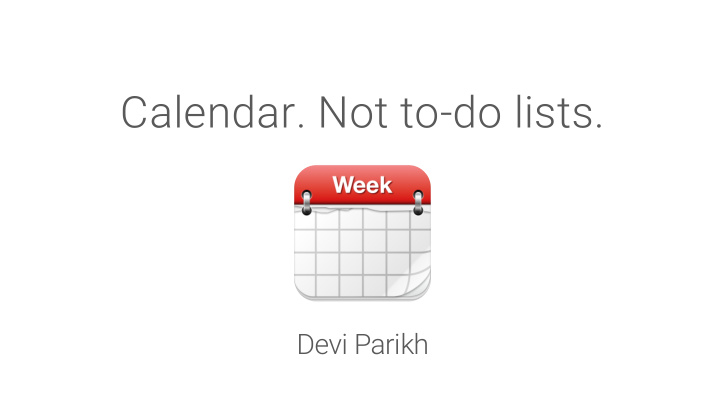



Calendar. Not to-do lists. Devi Parikh
Goal Be on top of things Avoid drama and stress
Assumption Your bottleneck is time management, and not motivation
Philosophy Calendars convert time to space Finiteness of time becomes apparent Just like physical space constraints are apparent
Methodology 1. Make every task a calendar entry 2. Do the task at that time 3. Move the task to a “done” calendar 4. Go to bed with an empty “to do” calendar • Either you got everything done • Or you re-planned
Principle 1 Everything takes time Everything needs to be on your calendar
Principle 1: Everything on your calendar Time is always ticking Time is finite Time is your bottleneck Plan with time being central Calendars. Not lists. Everything on your calendar Personal (routine, fun, errands, doing nothing) Professional (meetings, tasks, thinking, emails) Long term, recursive Nothing is too trivial Bonus: Nothing will get dropped
Principle 2 Incorporate your multiplier factor
Principle 2: Incorporate your multiplier factor What is a multiplier factor? Measuring it is easier than fixing it Measure it, incorporate it It will feel like an overkill, don’t ignore the data Your plan is now a feasible one If everything doesn’t fit, prioritize Don’t be delusional Bonus: Measuring the multiplier is a first step towards approaching 1.0
Principle 3 Incorporate your patterns
Principle 3: Incorporate your patterns Unexpected things tend to happen at work Kids Not a morning person Friends tend to make impromptu plans on Saturdays Tend to be too tired on Sundays Give yourself plenty of buffer Don’t mix in other battles
Principle 4 Re-plan
Principle 4: Re-plan Plan is feasible, but not guaranteed Move things to other open slots Ripple effect based on urgency After re-planning, you once again have a feasible plan Rinse and repeat A successful day is not when you get everything you planned to do that day done. It is one when you can go to bed with a feasible plan for every day ahead. Re-planning is not failure. Re-planning is part of the plan. Bonus: The high of the “done” move
Principle 5 Break it down
Principle 5: Break it down Not everything comes in calendar-sized chunks Break it down Pro-tip: Make making a plan a calendar entry
Principle 6 Backtrack Foresee
Principle 6: Backtrack. Foresee. Backtrack: A conference deadline is 3 months out... Foresee: A week before the conference deadline tends to be crazy You can’t get work done when family is visiting Surfaces when things are more urgent than they seem to be You’ll know. Things won’t “fit”! Pro-tip: Backtracking tells you the *latest* by when you need to get something done! Pro-tip: You need buffers to be able to re-plan.
Principle 7 Visualize your time
Principle 7: Visualize your time Every night What is tomorrow going to be like? Every Sunday What is next week going to be like?
Summary: Methodology 1. Backtrack, foresee 2. Make every task a calendar entry • Incorporate multiplier and patterns • Break it down 3. Do the task at that time 4. Move the task to a “done” calendar 5. Visualize your tomorrow 6. Go to bed with an empty “to do” calendar • Either you got everything done • Or you re-planned
Calendar. Not to do lists. https://blog.usejournal.com/calendar-in-stead-of-to-do-lists-9ada86a512dd
Emails Goal: Zero inbox When you first see an email, read it entirely If nothing needs to be done: archive it If you need to reply and can do it now: reply and archive If you need to do something before you can reply: put that task on your calendar, archive the email So only emails in your inbox are ones you haven’t read (or are emails you read in a rush – e.g., walking between meetings)
Calendar. Not to do lists. https://blog.usejournal.com/calendar-in-stead-of-to-do-lists-9ada86a512dd
Recommend
More recommend